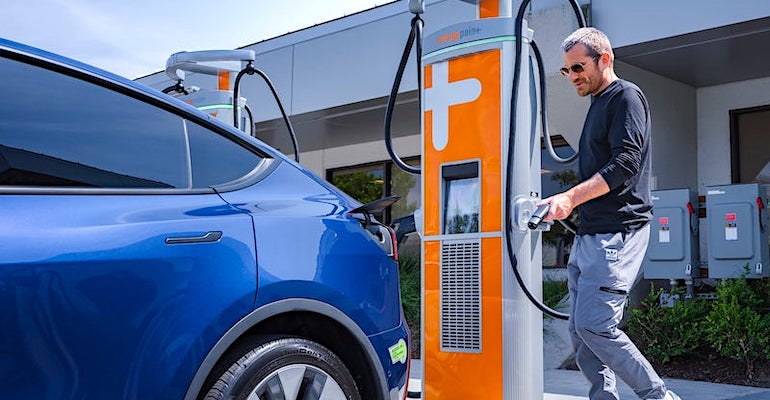ChargePoint Is Supporting Both CCS and NACS Charging During the Transition
The EV industry’s alignment behind Tesla’s NACS charging standard will take years.

Car industry support for the compact and simple Tesla North American Charging Standard plug is gaining momentum, with regular announcements of support from carmakers and public charging networks since Ford CEO Jim Farley made the surprise announcement that Ford would switch to Tesla’s NACS ports on its cars within a few years.
In the meantime, carmakers like Ford that have announced their intention to switch the charging ports on their cars will continue building cars using the Society of Automotive Engineers Combined Charge System ports.
As the “combined” portion of the name suggests, CCS plugs combine separate ports for SAE J1772 AC charging and DC charging into a single bulky plug. Tesla’s slender NACS plugs work for both AC and DC charging. During the time it will take for NACS vehicles to dominate American roads, public charging networks will need to support both, points out Bill Loewenthal, Chief Product Officer at ChargePoint.
“Our highly modular charging platforms, combined with our new NACS connector options, allow customers to be confident that their investment in EV charging is successful for any connector scenario,” he said. “We remain committed to developing networked charging solutions that ensure any EV can charge in any parking space.”
Chargepoints customers in this reference are the host companies that operate public charging stations using the company’s equipment. “ChargePoint’s 15-year history as a leader in the EV revolution has prepared us for evolving market dynamics, as well as enabled us to predict customer and driver needs,” Loewenthal noted.
Indeed, the company started working on its new NACS charging products more than a year ago because it recognized the value to public charging station operators to be able to offer charging to Tesla drivers without requiring an adapter for the connectors, he said. Thanks to that head start, the company will ship cables with NACS connectors later this year, Loewenthal added.
When they do, owners of ChargePoint charging stations will be able to add these cables to the existing chargers in a modular fashion. The company points out that its charging stations are designed to be modular so that existing charging site hosts can replace, repair, or exchange charging cables and connectors, including NACS connectors, as needed.
What is important is that the host companies operating charging station sites should ensure that none of their charging spaces is dedicated only to a single type of charger, as this could leave drivers unable to charge in an available space, Loewenthal said. “One has to be very careful,” he said. “You do not want to dedicate a connector type to a parking space. Then you strand an audience. You should be able to charge any vehicle in any parking space.”
Despite the complication of multiple charging standards during the industry shift to NACS, the change will be worthwhile in the end, Loewenthal said. “In some respects, this is good for the industry to simplify this for drivers,” he said. “It will take some time, several years or more, to sort itself out. It is creating some uniformity in what automakers can plan for and consumers can experience.”
About the Author(s)
You May Also Like


.jpg?width=300&auto=webp&quality=80&disable=upscale)


